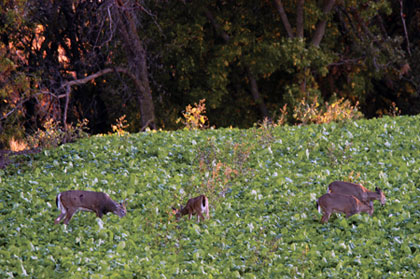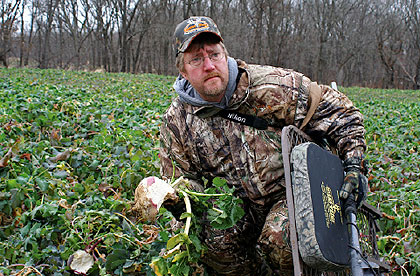
Food plot implementation, type and timing can vary greatly between the northern and southern climes, but effective management strategies can produce great results regardless of the location.
The stand had been hot all season long. I’d created the half-acre opening early that summer, approximately 100 yards back in the cover from the large field. After I had thoroughly worked up the ground, the local feed mill dumped the exact amount of lime and fertilizer my soils test had called for. A light disc was followed by a once-over with a culti-packer.
As critical as those steps were, my next was even more so. The seed I’d selected for the plot was Antler King’s Trophy Clover Mix. A quick broadcasting of the seeds at approximately 1.5 times the recommended amount and one more culti-packing, and all that was left was praying for rain and waiting the month and a half for the season to start. The rains came and the plot thrived.
Fast-forwarding to mid-October, I’d already passed numerous bucks and had a dangerously close encounter with the largest buck in the area on that food plot. Each sit, I was literally covered up in deer. However, it was the doe that I now watched slowly approaching the food plot that would be responsible for filling my tag.
Flicking her tail side to side, fanning herself, it was obvious that she was close to entering estrous. Apparently, that was equally obvious to the wide 10-pointer that was closing on her fast. Five minutes later, I settled the pin and let the Rage-tipped Easton fly from my bow. One of only two bucks I considered shooters in the area were mine, and I’d nearly gotten the other one a few days before. When done properly, food plots truly can deliver amazing results!
MATCHING SEED TYPE TO THE AREA
As I briefly touched on above, there are many things that go into creating a thriving food plot. Simply put, selecting the appropriate seed type is at the top of the list.
Back in college, I had a two-year internship with a large seed company. Despite the million-dollar title, my position as a “Sunflower Breeder’s Research Technician” was mostly that of a glorified migrant worker. However, I did actually get the opportunity to create two separate lines of sunflower seeds that were eventually packaged for sale.
Despite botany and genetics classes preaching the same thing, it was really that internship that drilled into my head that every strain of seed on the market is different. All sunflower seeds are not created equal. They are each bred for specific traits.
This could be seen clearly in the two strains I produced. One, a shorter strain with a very thick stalk and smaller head, was designed to grow in the flat lands of the Dakotas, where high winds would decimate a thin-stalked, taller sunflower with a larger head. The other, designed to be planted in the more rolling country of Wisconsin, was taller and had a larger head, to maximize seed production.

Seed blends like Antler King’s Honey Hole can yield massive tonnage per acre in the upper Midwest and northern climes. Photo courtesy of Steve Bartylla.
Though I’m sure many were bored to tears by that recount of my college years, it served the important point of illustrating that all seed lines of the same plant type are not the same. Heck, they’re often not close to the same. Believe me when I tell you that this applies every bit as much to food plot seed blends as it does to sunflowers.
A great example of this is Buck Forage Oats. Most varieties of oats that are planted north of the Mason-Dixon line will die off after the first decent frost. Buck Forage Oats is specifically packaged with frost-tolerate oats. Therefore, they are more frost-tolerant that other options.
Still, they have their limits. Because of this, they will do better in Illinois, Iowa, Missouri and even southern Minnesota and southern Wisconsin than in points farther north. In the more northern regions, odds are significantly higher that a killing frost will cripple the planting before December hits, and often as early as October.
On the other hand, Antler King’s Fall/Winter/Spring mix consists of winter peas and winter rye. When a killing frost hits, the winter rye simply goes dormant until the temps rise above freezing and then resumes growing. A planting such as this is ideally suited for the coldest regions of a whitetail’s range.
BRASSICAS
Antler King’s Honey Hole and Frigid Forage’s Big-N-Beastly brassicas take a different approach. In both cases, the seed blends contain varieties of rape and turnips. Frigid Forage’s blend also contains sugar beets and carrots.
In both cases, the deer feed heavily on the greenery while it’s growing. In the case of rape, a hard frost causes the sugars to come up from the roots and into the leafy growth. This increases their desirability to deer.
Next, the turnips, beats and carrots become most desirable after hard frosts kill the plants altogether. Because of the massive tonnage per acre that each blend’s leaves and roots provide, they offer the northern hunters more than a season-long food source. When planted in adequate amounts and with a variety of other food sources, deer can be found feeding in these food plots all the way up until spring melt.

